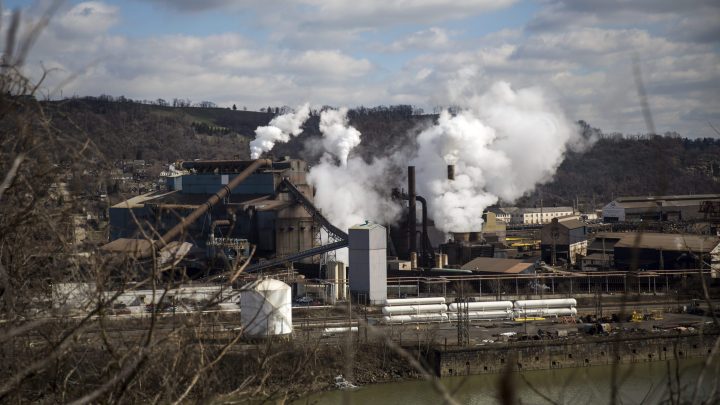
Higher tariffs may be bad for trade, but good for the environment
Higher tariffs may be bad for trade, but good for the environment

The United Nations Climate Change Conference will kick off in Dubai on Nov. 30. The two-week event, known as COP28, will give countries an opportunity to “reboot” their efforts to cut carbon emissions in half by 2030, the UN said.
The conference will focus on a few familiar themes, including investing in renewable energy and cleaner urban infrastructure, and scaling up private investment in climate solutions.
One emerging theme is trade policy and the role it can play in reducing global carbon dioxide emissions.
For decades, the conventional wisdom in trade theory has been that tariffs have a downside: They increase prices for everybody.
“Any increase in U.S. producers’ input prices is going to filter down to somebody, whether it’s reduced profits for U.S. companies, which may affect employment and investment, or higher prices directly to the consumer,” said Kadee Russ, an economics professor at the University of California, Davis.
The newer thinking is that higher prices for certain imports might actually be good for the environment. One example is the steel industry.
At a scrap yard called Lee’s Iron & Metal near San Diego, California, two excavators sort through huge mounds of metal. One of the excavators grabs a pickup truck and lifts it into a machine that crushes it into a cube.
“You’ll see car bodies, you’ll see refrigerators, you’ll see water heaters,” said George Vasquez, the yard’s supervisor.
Lee’s Iron & Metal buys this scrap from people who drop off old junk, construction companies and government agencies. And once owner Steve Glucoft’s crew sorts the metal and compresses it, his company sells it.
“A little bit to Taiwan,” Glucoft said. “A little bit to Vietnam. We also sell into Mexico. And then, of course, there is the forever-changing U.S. market.”
Glucoft sells a lot of metal directly to American steel mills. They’ve been melting down recycled metal since the 1970s using machines called electric arc furnaces. More than 70% of steel in the U.S. is now made this way, according to the Steel Manufacturers Association.
That is a very different process than the old-fashioned method of mining raw materials and burning coal.
The industry had good reasons to switch to the electric method, said Allan Collard-Wexler, an economics professor at Duke University.
“It both didn’t have to use coal, and also just used a lot less, essentially, heat to produce new steel,” he said.
As a result, steel production in the U.S. is a lot cleaner than it was up until the 1970s. But other big steel-producing countries, including India and China, are still burning coal to make steel from scratch. Collard-Wexler said that’s because those countries don’t have enough scrap metal lying around.
“To have scrap steel lying around, you would have needed to produce steel for the last 100 years,” he said. “China just hasn’t had the same industrial expansion in the 1890s and 1900s that the U.S. had in the steel sector.”
For decades, that dirty steel wasn’t subject to much in the way of tariffs, while goods produced with smaller carbon footprints, including vehicles, had higher tariffs, said Joe Shapiro, an economics professor at the University of California, Berkeley.
“You could think of that as a subsidy to greenhouse gas emissions, because we’re charging lower tariffs on imported goods that are emitting more greenhouse gasses,” Shapiro said.
Shapiro looked into what would happen if every country simply set a single tariff for everything. He found that demand for dirtier goods would fall, which would make a big dent in global carbon dioxide emissions.
“It would have a similar impact on global greenhouse gas emissions as if the U.S. put a substantial limit on greenhouse gas emissions from energy-intensive industries,” Shapiro said.
The Donald Trump administration raised tariffs on imported steel in 2018. A report from the International Trade Commission found that those tariffs increased steel production in the U.S. by about 2%, even though American steel is more expensive than Chinese steel because of higher labor and environmental compliance costs.
Kadee Russ at UC Davis said it’s still too early to tell whether trade theory is starting to factor in the potential environmental benefits of higher tariffs.
“I haven’t heard it sinking meaningfully into policy debate at this point, which is shocking to me,” she said.
Even if reduced global emissions are an unintended consequence of tariffs on imported steel, Russ said that it’s a welcome one.
There’s a lot happening in the world. Through it all, Marketplace is here for you.
You rely on Marketplace to break down the world’s events and tell you how it affects you in a fact-based, approachable way. We rely on your financial support to keep making that possible.
Your donation today powers the independent journalism that you rely on. For just $5/month, you can help sustain Marketplace so we can keep reporting on the things that matter to you.

















